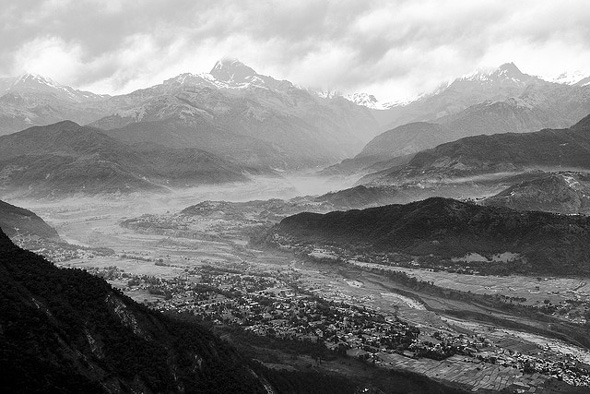-
Russell Sticklor, Stimson Center
The Race to Harness Himalayan Hydropower
October 11, 2012 By Wilson Center Staff
The original version of this article, by Russell Sticklor, appeared at the Stimson Center.
Spend a day in Kathmandu, Nepal’s sprawling capital of four million people, and you’ll quickly notice what has long been a fact of life in this landlocked Himalayan country, and many other South Asian nations – no reliable electricity supply exists. Up to eight times a day, neighborhoods throughout the city suffer rolling power cuts due to load shedding, causing residents and businesses alike to either carry on in the darkness or rely on expensive, diesel-consuming generators to keep the lights on. Although the country’s civil war ended in 2006, carrying the promise of restored domestic stability and accelerated economic development, Nepal’s economy has remained hamstrung by an inconsistent energy supply, with only 40 percent of the population having access to electricity. This situation persists despite the fact that the country sits on top of a virtual goldmine – an estimated 80,000 megawatts (MW) of untapped hydroelectricity, of which it has harnessed a scant 700 MW.
Nepal’s great untapped hydropower potential has not gone unnoticed. Neighbors India and China actively have courted the country for years, seeking dam construction contracts and energy export deals to help meet their own soaring domestic energy needs. But while some Nepalese hydroelectric projects have moved forward, some of the country’s more ambitious hydroelectric development plans have been delayed or scrapped altogether since 2006, owing to Nepal’s notoriously fractious internal politics and persistent social unrest near proposed dam-construction sites in rural areas formerly sympathetic to the Maoist insurgency. One reason for the impasse surrounding many major hydroelectric projects is that Nepal has long been wary of foreign meddling in its internal affairs, which has meant that Indian and Chinese efforts to bankroll major infrastructure projects are automatically viewed with suspicion.
India and China have become locked in competition to ink construction contracts in Bhutan and Burma as well, two countries similarly spanned by the Himalaya that possess substantial undeveloped hydroelectric resources. Bhutan and Burma have both embraced the idea of heightened hydroelectric development, reflecting a different attitude than Nepal’s regarding both energy infrastructure and foreign contractors. Bhutan would benefit greatly from increased domestic power production, given that it now uses only 390 MW of its 30,000 MW hydropower potential (or 1.3 percent). Even at that modest level of development, hydropower has already emerged as one of the mainstays of the Bhutanese economy, alongside tourism. However, the country currently lacks the technical resources to further bolster its hydroelectric capacity, a vacuum that state-owned Indian energy firms have rushed to fill. Indian firms have competitive advantage over in China in this regard, as Chinese-Bhutanese relations have remained tense over the years due to persistent quarreling over contested border areas. As a result, many of the country’s high-profile hydroelectric projects – such as the 2,500 MW Sankosh River Hydropower project, slated to become the world’s fifth tallest dam upon completion in 2016 – are contracted to Indian companies.
Continue reading at the Stimson Center.
Sources: Asian Power, Clean Energy Nepal, The Hindu, Indian Ministry of External Affairs.
Photo Credit: Seti River Valley, courtesy of flickr user Jan Zalud.
Topics: Bhutan, China, development, economics, energy, environment, India, Myanmar, natural resources, Nepal, security, water
 A Publication of the Stimson Center.
A Publication of the Stimson Center.



